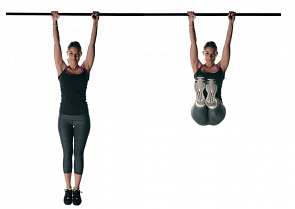HANGING LEG RAISES

Nothing is as effective for the abs as hanging leg raises on the bar. This exercise requires some physical preparation, and in order for it to give the desired result and not harm, you must follow the instructions exactly. We share the technique of performing leg raises on the crossbar.
BASIC INFORMATION
Exercise types
There are several variations of this exercise:
- Raising straight legs on the bar.
- Raising the bent legs on the bar.
- Raising the bent legs on the uneven bars.
- Hanging leg raises with a clamped ball or dumbbells – on a horizontal bar, uneven bars or a crossbar.
All of these exercises are designed for the abdominal muscles, while using different additional muscle groups. The most serious level of training requires lifting straight legs in the hang on the crossbar and lifting with a clamped ball, for the rest, an average level is enough. Let’s take a closer look at each exercise.
What muscles work
When raising your legs to the bar, the following muscles work:
- Oblique and straight abdomen.
- Iliopsoas.
- Strain of the fascia lata of the thigh.
- Tailoring, comb, long and short adductors.
- Rectus femoris muscle.
The exercise begins with the work of the hip flexor muscles, then the rectus and oblique abdominal muscles are connected. When bending the legs in the hang, the main load is on the abdominal muscles.
Benefits
- A large number of muscles are immediately involved.
- A muscular corset develops, which is needed for correct posture.
- When hanging there is a beneficial stretching of the spinal column.
- Can be used for back pain or problems.
- Variety of execution.
RAISING STRAIGHT LEGS ON THE BAR
Step-by-step instruction
Step 1. Hang on the horizontal bar so that your feet do not reach the floor. To do this, you can jump, and if there is not enough height, use a bench or the support of a coach. Grip – straight: medium or wide.
Step 2. Fully straighten your arms and legs, and bend your back slightly in the lumbar region.
Step 3. Take a deep breath and pull your legs back slightly.
Step 4. With a jerk, lift your legs to the bar to the maximum possible height – if done well, they should be slightly above the horizontal position. Professionals can touch the bar with their socks.
Step 5. Stop for a second at the highest level. For maximum exercise benefit, tighten your abdominal muscles further.
Step 6. Inhale and slowly lower your legs, focusing on the muscles being worked out.
Step 7. Perform the required number of repetitions.
Implementation tips
- Avoid inertia and sway during the exercise.
- Move slowly for a clean execution.
- At the end, hold for 1-2 seconds and further tighten your abdominal muscles.
- If you have a lot of weight, then instead of a horizontal bar, you should use bars with a back.
- To prevent the arms from splitting on the bar, you can use shoulder straps or wrist straps.
- You can start from the wall bar and lift bent legs – this way you will significantly reduce the load.
- An advanced option is weighted leg raises.
- You can change the height of the legs, depending on the desired load.
- It is best to perform the exercises in 2-3 sets of 10-15 repetitions.
HANGING BENT LEG RAISES ON THE BAR
Working muscles
As in the previous exercise, when lifting with bent legs, the main load falls on the rectus and oblique abdominal muscles. Additionally, the rectus muscles of the thighs and the iliopsoas muscle are involved. The shoulder blades, shoulder joints and abdominal muscles act as stabilizers.
Step-by-step instruction
Step 1. Grasp the bar with a wide or medium grip.
Step 2. Fix in a position with straight arms and legs, back slightly bent at the lower back.
Step 3. First take a deep breath, and then as you exhale, pull your legs to your chest as high as possible.
Step 4. Freeze for a second in this position and tighten your abdominal muscles.
Step 5. Slowly lower your legs, return to the starting position.
Step 6. Do the required number of repetitions.